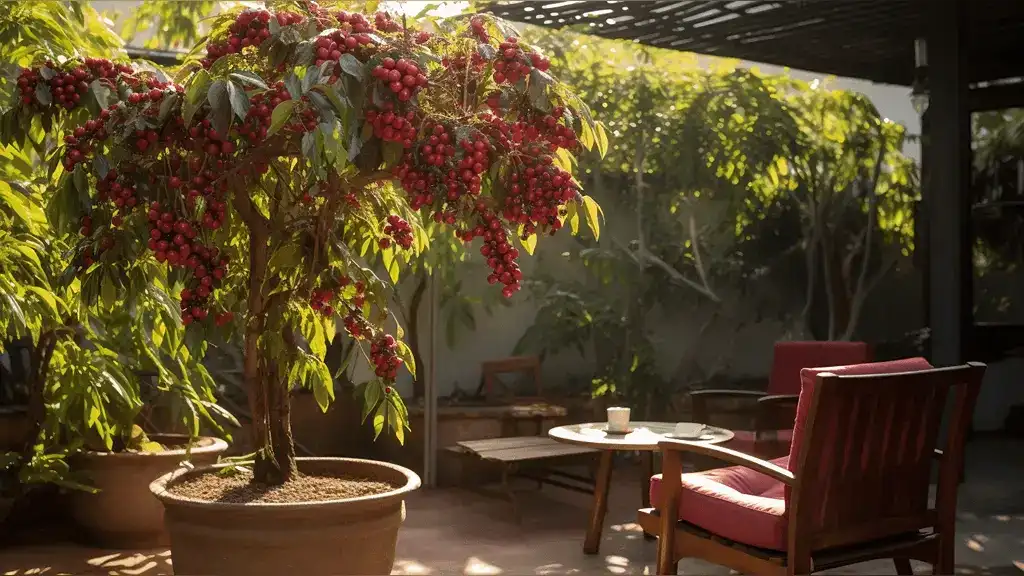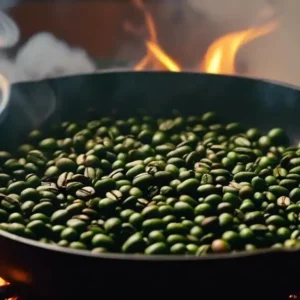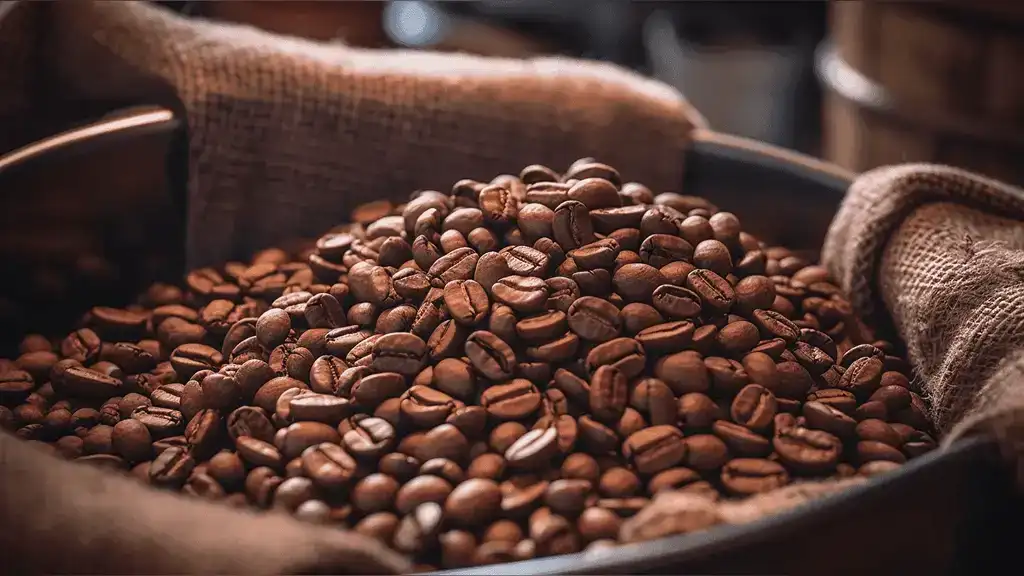If you’re a coffee enthusiast, you’ve likely wandered through the lush, diverse forest of coffee varieties, each one a unique flavor landscape waiting to be explored.
Amidst this rich terrain, Liberica coffee stands like a mysterious, yet intriguing, hidden gem. This robust and complex bean has a story as bold as its flavor, and understanding its essence could transform your coffee experience in ways you never imagined.
So, as you savor your morning cup, ponder this – what makes Liberica coffee so captivating, and why should you pay attention to this enigmatic coffee variety?
As a professional barista with over a decade of experience in the coffee industry, I have had the privilege of working with various coffee varieties, including Liberica, and I am excited to share my insights with you.
What is Liberica Coffee?

So, what exactly is Liberica coffee?
Well, Liberica coffee has a fascinating historical background, as it was discovered in Liberia and later became popular in Asia and the Philippines.
Its unique flavor and larger bean size set it apart from other coffee varieties, and it has gained a global following, especially in regions where it’s cultivated.
Discovery and Historical Background
Discovered in Liberia in the 19th century, Liberica coffee is a unique and lesser-known species of coffee bean with a rich historical background.
Its journey began when it was brought to the Philippines, a country in Southeast Asia, where it gained prominence.
In the late 1800s, the coffee industry faced a crisis as a result of the spread of coffee rust disease, which affected the dominant Arabica coffee plants. This led to the introduction of Liberica coffee as an alternative, and it thrived in the Philippines.
Its distinct flavor and resilience to disease made it a valuable asset to the coffee industry.
Over time, Liberica coffee has become an integral part of the history of coffee cultivation in the Philippines and has contributed to the diversity of coffee flavors enjoyed by coffee enthusiasts worldwide.
Spread and Adoption Globally
Widely recognized for its large, irregular-shaped beans and unique flavor profile, Liberica coffee has gained global attention and adoption in recent years. Once considered a niche coffee variety, Liberica is now cultivated and harvested in various regions worldwide, contributing to its increased production and availability.
Its distinct taste, often described as bold and full-bodied with a woody or floral aroma, has attracted coffee enthusiasts looking for new and diverse flavors. The spread and adoption of Liberica coffee globally can be attributed to its resilience to certain diseases and pests, making it an appealing option for coffee farmers in different climates.
As a result, the demand for Liberica coffee continues to grow, with more consumers seeking out this unconventional and captivating coffee experience.
Defining Characteristics of Liberica Coffee
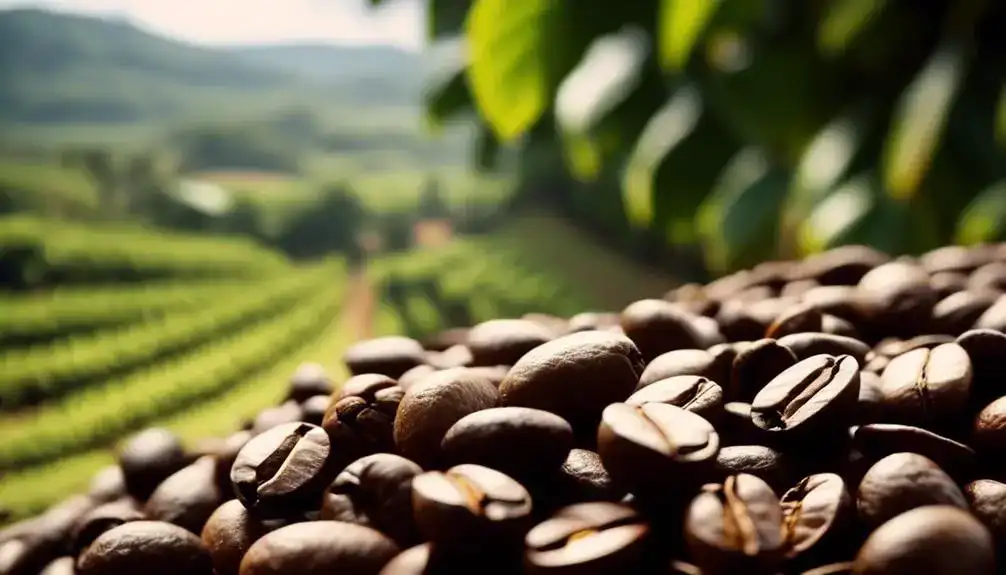
When it comes to Liberica coffee, understanding its defining characteristics is essential for appreciating its uniqueness. Let’s take a closer look at the botanical features, taste, and aroma profile of Liberica coffee. To help you understand these defining characteristics better, here’s a simple breakdown:
| Botanical Features | Taste Profile | Aroma Profile |
|---|---|---|
| Large, asymmetrical beans | Full-bodied, woody, and floral notes | Fruity, nutty, and smoky aromas |
Botanical Features
When it comes to Liberica coffee, the plant size and appearance play a key role in its identification. The distinctive bean shape and size are also defining characteristics of Liberica coffee. These features set Liberica coffee apart from other varieties and contribute to its unique flavor profile.
Plant Size and Appearance
What distinguishes the botanical features of Liberica coffee plants?
Liberica coffee plants are known for their large size, reaching up to 20 meters in height. The leaves are broad and elongated, often measuring over 20 centimeters in length.
These plants thrive in low-altitude regions, making them suitable for plantation farming.
Unlike Arabica and Robusta, Liberica coffee plants are more resistant to leaf rust, enhancing their appeal to farmers in various environments.
Bean Shape and Size
The distinctive botanical features of Liberica coffee plants extend to their bean shape and size, which contribute to the unique characteristics of this coffee variety.
- Bean Size: Liberica coffee beans are notably larger than those of other varieties.
- Bean Shape: They’ve an asymmetrical shape, setting them apart from the more common coffee bean varieties.
- Cherries: The beans are found within large cherries, adding to their distinct appearance.
- Processing: Liberica beans require unique processing methods due to their size and shape.
Taste and Aroma Profile
When it comes to Liberica coffee, you’ll be surprised by its unique flavor notes that set it apart from Arabica and Robusta. To give you a better idea, here’s a comparison of the taste and aroma profiles of these coffee varieties:
| Liberica Coffee | Arabica Coffee | Robusta Coffee | |
|---|---|---|---|
| Flavor Notes | Floral, fruity, woody | Sweet, soft acidity, complex | Bitter, earthy, nutty |
| Aroma | Unique and intense | Floral and fruity | Neutral or sometimes described as peanut-like |
Unique Flavor Notes
With its robust and distinctive flavor profile, Liberica coffee stands out among other coffee varieties for its rich and complex taste and aroma.
The flavor of Liberica coffee is truly unique, often described as fruity and floral with hints of dark chocolate and a lingering, earthy finish.
Its aroma is equally distinctive, offering a captivating blend of fruity, floral, and woody characteristics that set it apart from other coffee varieties.
Comparison with Arabica and Robusta
Pivoting from the unique flavor notes of Liberica coffee, its taste and aroma profile distinguish it significantly from Arabica and Robusta varieties. Liberica boasts a distinctive fruity and floral taste, with hints of a woody or smoky aroma, setting it apart from the more common Arabica and Robusta varieties. Here’s a quick comparison of the tasting attributes of these three coffee types:
| Attributes | Liberica | Arabica | Robusta |
|---|---|---|---|
| Taste | Fruity, Floral | Sweet, Tangy | Neutral, Nutty |
| Aroma | Woody, Smoky | Floral, Fruity | Earthy, Chocolaty |
Growing Liberica: Regions and Methods
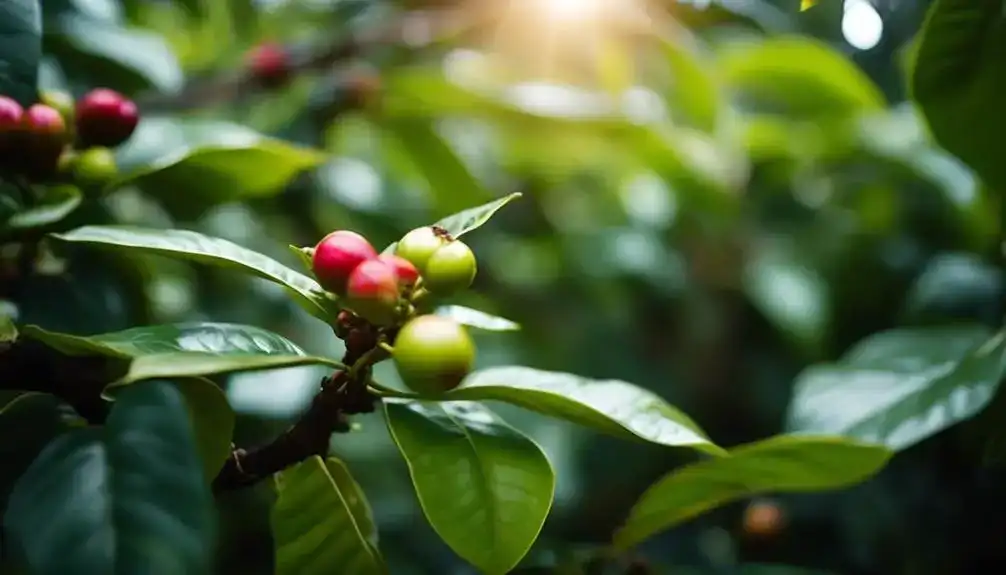
Now it’s time to explore the primary growing regions and agricultural practices of Liberica coffee.
You’ll discover the specific areas where Liberica thrives and the methods used to cultivate this unique coffee bean.
Understanding the regions and methods involved in growing Liberica is essential to appreciating its distinct flavor profile.
Primary Growing Regions
When it comes to growing Liberica coffee, it’s essential to know about the primary growing regions and the methods used. To help you understand better, here’s a table that provides country-specific profiles and the environmental conditions that contribute to the unique flavor profile of Liberica coffee.
| Country | Environmental Conditions |
|---|---|
| Philippines | High humidity, volcanic soil |
| Malaysia | Equatorial climate, rich rainfall |
| Liberia | Tropical rainforest, high elevation |
| Ivory Coast | Tropical climate, rich biodiversity |
| India | Tropical weather, well-drained soil |
Country-Specific Profiles
Liberica coffee is primarily grown in the regions of West Africa and Southeast Asia, where unique methods and conditions contribute to its distinct flavor profile.
- West Africa: Liberia and Ivory Coast are the major producers.
- Southeast Asia: The Philippines and Malaysia are known for their Liberica cultivation.
- Growing Methods: Liberica is often grown in smallholder farms using traditional methods.
- Geographic Distribution: The equatorial climate in these regions provides ideal conditions for Liberica cultivation.
Environmental Conditions
In the primary growing regions of West Africa and Southeast Asia, the equatorial climate and traditional farming methods create the essential environmental conditions for cultivating Liberica coffee.
- Soil: Rich volcanic soil provides the ideal foundation for Liberica coffee plants to thrive.
- Climate: The consistent warmth and high humidity in these regions support the resilience of the Liberica coffee plant.
- Conservation: Traditional farming methods promote sustainability and conservation of the natural environment.
- Sustainability: The cultivation of Liberica coffee aligns with sustainable agricultural practices, benefiting both the environment and the local communities.
Agricultural Practices
Now let’s talk about how Liberica coffee is grown and the agricultural practices involved.
You’ll learn about the different farming techniques used and how farmers manage pests and diseases to ensure a successful crop.
Understanding these agricultural practices will give you a deeper appreciation for the effort that goes into producing high-quality Liberica coffee.
Farming Techniques
Liberica coffee is primarily grown in Southeast Asia, particularly in the Philippines and Malaysia. The farming methods include traditional shade-grown practices, with trees providing the necessary cover for the coffee plants. Agricultural practices such as organic fertilization, proper irrigation, and pest control are essential for successful Liberica cultivation.
- Southeast Asia, especially Philippines and Malaysia
- Traditional shade-grown practices
- Organic fertilization
- Proper irrigation and pest control
Pest and Disease Management
To effectively manage pests and diseases in Liberica coffee cultivation, prioritize implementing integrated pest management strategies and disease-resistant varieties. This approach reduces the need for chemical pesticides and promotes a healthier ecosystem. Here’s a table summarizing common pest and disease challenges in Liberica coffee farming:
| Pest Management | Disease Management | Challenges |
|---|---|---|
| Integrated pest | Disease-resistant | Pests and diseases |
| management | varieties | climate change |
The Spectrum of Liberica Varieties

Now, let’s take a closer look at the key varieties of Liberica and the impact of processing on the flavors of this unique coffee. Understanding the different varieties and their flavor profiles will give you a deeper appreciation for the diversity within the Liberica family.
As we explore the processing effects on Liberica flavors, you’ll gain insights into the factors that contribute to the distinctive taste of this coffee.
Key Varieties of Liberica
Among the key varieties of Liberica coffee, there exists a spectrum of distinct flavors and characteristics that cater to a wide range of preferences and palates. Liberica is a specialty and rare coffee cultivar, known for its exotic taste and unique attributes.
One notable variety is the Baraco coffee, which originates from the Philippines and is celebrated for its rich, full-bodied flavor with a lingering, complex aftertaste.
Another renowned variety is the Excelsa coffee, hailing from Southeast Asia, which offers a fruity and tart profile, often likened to a combination of dark and light roasts.
Liberica’s range also includes the Ivory Coast variety, esteemed for its delicate, floral aroma and mild, yet satisfying taste.
Each of these key Liberica varieties presents an opportunity for the adventurous coffee enthusiast to savor something truly distinctive and extraordinary.
Processing Effects on Liberica Flavors
When processing Liberica coffee, the method used can significantly impact the flavor profile of the beans.
Natural processing, where the coffee cherries are dried whole, tends to result in a fruitier and fuller-bodied taste, while washed processing, involving the removal of the fruit before drying, can produce a cleaner and brighter flavor.
Understanding the spectrum of Liberica varieties and the effects of different processing methods can help you appreciate the diverse and unique flavors this coffee has to offer.
Natural vs. Washed Processing
In understanding the spectrum of Liberica varieties, it’s essential to grasp the impact of natural and washed processing on the flavors of Liberica coffee. Natural processing accentuates the fruity and wild flavors, while washed processing yields a cleaner taste with brighter acidity. Embrace the freedom to explore these distinct profiles through various brewing methods, allowing you to savor the rich diversity of Liberica coffee.
| Natural Processing | Washed Processing |
|---|---|
| Fruity flavors | Cleaner taste |
| Wild notes | Brighter acidity |
| Unique profile | Distinctive taste |
Impact on Taste
Exploring the impact of natural and washed processing on Liberica coffee flavors, you can discern the distinct profiles and unique taste characteristics that define the spectrum of Liberica varieties.
The processing method significantly impacts the taste, affecting the brewing process and overall quality. Natural processing enhances the fruity, full-bodied flavors, while washed processing results in a cleaner cup with brighter acidity.
Both methods maintain Liberica’s naturally low caffeine content, contributing to its smooth taste.
Brewing and Enjoying Liberica Coffee
When it comes to brewing Liberica coffee, you’ll want to explore the recommended techniques that can bring out its unique flavors.
Additionally, comparing its caffeine content to other coffee varieties will help you understand its impact on your daily caffeine intake.
Embracing the process of brewing and enjoying Liberica coffee will enhance your coffee experience and deepen your appreciation for this distinct coffee bean.
Recommended Brewing Techniques
When it comes to enjoying Liberica coffee, it’s essential to know the best practices for extraction and how to pair it with foods. To help you get the most out of your Liberica coffee experience, here are some recommended brewing techniques and food pairings to elevate your enjoyment. Check out the table below for a quick reference guide on how to best brew and enjoy your Liberica coffee.
| Brewing Techniques | Food Pairings |
|---|---|
| French Press | Chocolate desserts |
| Pour Over | Fresh fruit |
| Cold Brew | Spicy snacks |
| Espresso | Nutty pastries |
| Turkish Coffee | Citrus-flavored dishes |
Best Practices for Extraction
For optimal extraction and flavor, employ the recommended brewing techniques when preparing Liberica coffee.
- Grind the coffee beans to a coarse consistency to ensure proper extraction.
- Use water just off the boil to extract the unique flavors of Liberica coffee.
- Allow the coffee to bloom for 30 seconds before fully brewing for enhanced taste.
- Experiment with different brewing methods and ratios based on your personal research and taste preferences.
Pairing with Foods
As you explore the recommended brewing techniques for Liberica coffee, you’ll discover the delightful harmony it creates when paired with various foods.
- Liberica coffee from the geographic regions of Southeast Asia complements spicy traditional dishes.
- Its heritage in the Philippines makes it an ideal companion for local delicacies like bibingka and puto.
- Liberica’s distribution in West Africa pairs well with rich, chocolate-based desserts.
- Embracing Liberica coffee connects you to diverse cultural culinary experiences.
Caffeine Content Comparison
When it comes to caffeine content, it’s important to compare Liberica, Arabica, and Robusta coffee.
Each of these coffee varieties has different levels of caffeine, impacting your brewing and enjoyment.
Understanding the differences in caffeine content will help you make the most of your Liberica coffee experience.
Liberica vs. Arabica vs. Robusta
Comparing Liberica, Arabica, and Robusta coffees for their caffeine content reveals distinct differences in their brewing and enjoying experiences. Here’s a comparison of the caffeine content in a 6 oz (180 ml) cup of brewed coffee for each variety:
| Coffee Type | Caffeine Content |
|---|---|
| Liberica | High |
| Arabica | Moderate |
| Robusta | Very High |
These differences impact the strength and overall experience of each brew.
Liberica in the Coffee Market

Liberica coffee plays a significant economic role and holds cultural resonance in its producing countries. Its unique flavor profile and resilience to pests and diseases make it a valuable asset in the coffee market.
Understanding its impact and value is essential for appreciating the diversity and complexity of the coffee industry.
Economic Role and Value
With its unique flavor profile and growing demand, Liberica coffee plays a significant economic role in the global coffee market, contributing to its value and diversifying consumer options.
The economic importance of Liberica coffee lies in its ability to expand the coffee market by offering consumers a distinct flavor experience. As the demand for specialty and exotic coffee varieties continues to rise, Liberica provides an opportunity for economic growth and diversification within the coffee industry.
Its cultivation and preservation also support the economic stability of regions where it’s grown, promoting sustainable agricultural practices and contributing to local economies.
Additionally, Liberica coffee serves as an essential commodity for both import and export, further strengthening its economic significance in the global market.
Cultural Resonance in Producing Countries
When it comes to Liberica coffee, understanding consumer preferences and its role in the specialty coffee scene is crucial.
Liberica’s cultural resonance in producing countries has a significant impact on the coffee market.
Exploring the intersection of tradition, taste, and consumer demand sheds light on the unique position Liberica holds in the global coffee industry.
Consumer Preferences
In the coffee market, consumer preferences for Liberica are influenced by the cultural resonance it holds in producing countries. As a unique and flavorful beverage, Liberica’s demand is driven by its distinct taste and the cultural significance attached to it.
This cultural connection influences both supply and price, as producing countries strive to meet the demand while maintaining the authenticity and quality of the product.
Role in Specialty Coffee Scene
The cultural resonance of Liberica in producing countries significantly shapes its role in the specialty coffee scene.
As a specialty coffee, Liberica holds a unique significance for enthusiasts seeking to explore new flavors and trends. Its rarity and distinct taste contribute to its appeal in a market that values diversity.
Liberica coffee’s cultural roots and bold flavors make it a compelling choice for those looking to break away from traditional coffee experiences.
The Future of Liberica Coffee
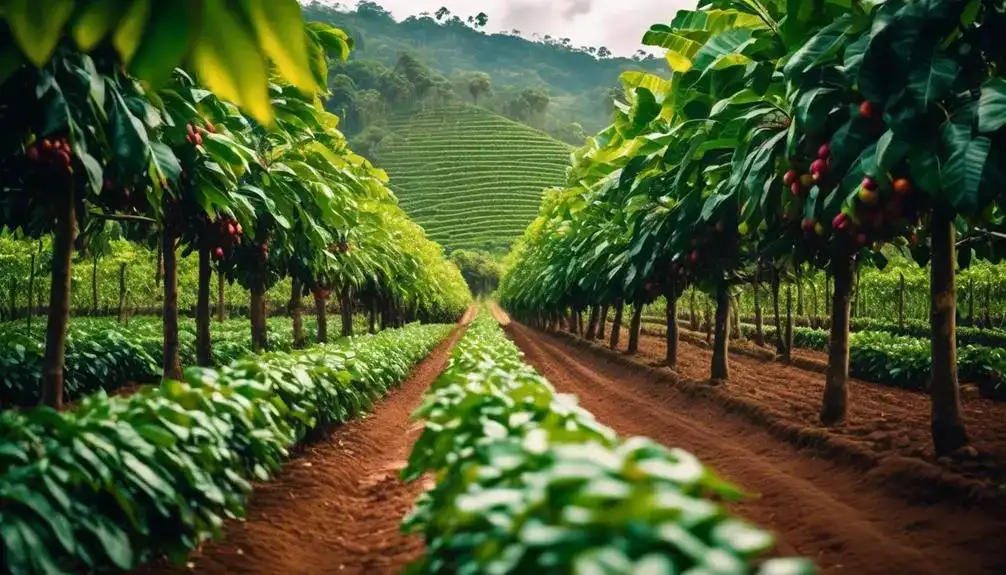
As you consider the future of Liberica coffee, it’s important to address the conservation and sustainability challenges it faces.
Initiatives for preserving Liberica are crucial for ensuring the continued availability and quality of this unique coffee variety.
Conservation and Sustainability Challenges
Conservation and sustainability challenges pose a significant threat to the future of Liberica coffee.
As demand for this unique coffee grows, the need for conservation efforts becomes more critical. Challenges such as deforestation, climate change, and limited growing regions impact the sustainability of Liberica coffee.
Efforts to address these challenges are essential to ensure the continued availability of this rare and flavorful coffee. The implications of not taking action could result in the loss of the Liberica coffee bean, depriving future generations of its distinct taste and cultural significance.
Initiatives for Preserving Liberica
To ensure the future of Liberica coffee, you need to focus on research and development to enhance its resilience and flavor profile.
Market expansion efforts are crucial in introducing Liberica to a wider audience, creating more demand and securing its place in the coffee industry.
Research and Development
Preserving Liberica coffee for future generations requires innovative research and development initiatives to ensure its sustainability in the ever-changing coffee industry.
Researchers in Malaysia and Africa are studying the best conditions for growing Liberica, aiming to improve its resistance to diseases and environmental stress.
Through ongoing research and development efforts, the future of Liberica coffee looks promising, offering hope for its continued existence and availability for coffee enthusiasts worldwide.
Market Expansion Efforts
What strategies are being implemented to expand the market for Liberica coffee and ensure its long-term availability for coffee enthusiasts worldwide?
To promote Liberica’s consumption, advocacy efforts are underway, creating awareness of its unique flavor profile. Recommendations include partnering with local farmers, educating consumers, and fostering sustainable cultivation practices.
Market expansion initiatives aim to preserve this distinct coffee variety and provide freedom of choice for discerning coffee drinkers globally.
Conclusion
So there you have it, Liberica coffee, the unique and underrated treasure of the coffee world.
As you sip your mainstream, mass-produced coffee, just remember that there’s a whole world of Liberica waiting to be explored.
It’s a shame that so many people are missing out on this bold and distinctive flavor, but hey, more for those of us in the know, right?
Cheers to the underdog of the coffee world!






